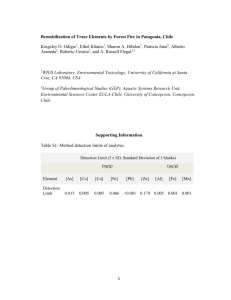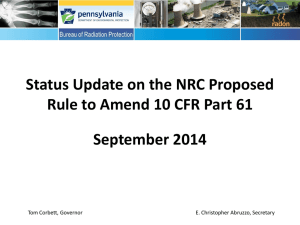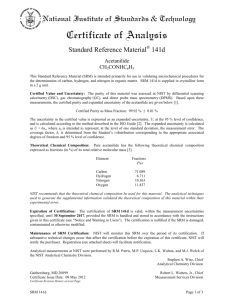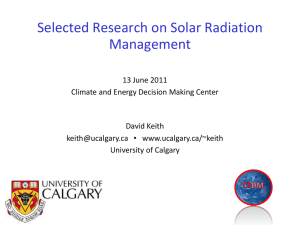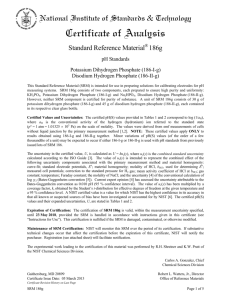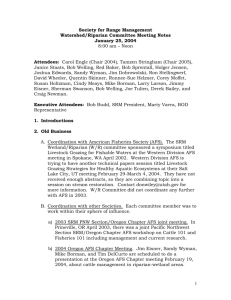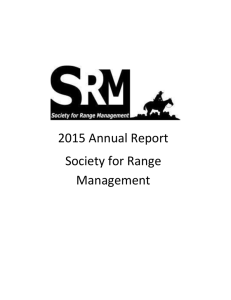Online Supplement METHOD VALIDATION FOR THE ANALYSIS OF
advertisement
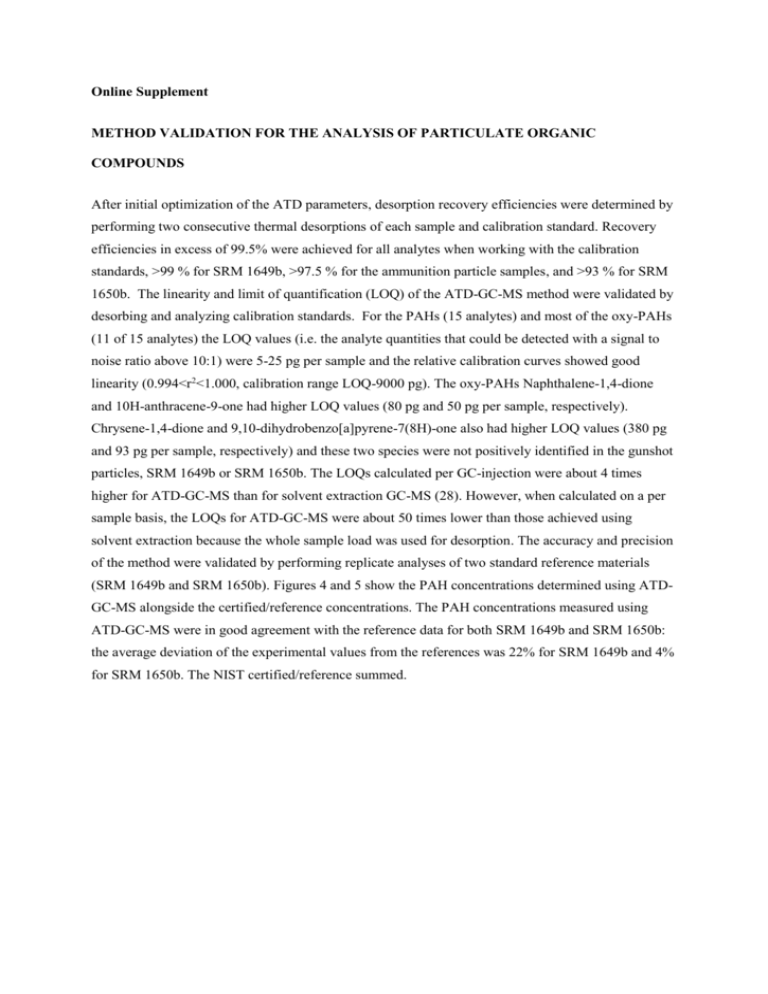
Online Supplement METHOD VALIDATION FOR THE ANALYSIS OF PARTICULATE ORGANIC COMPOUNDS After initial optimization of the ATD parameters, desorption recovery efficiencies were determined by performing two consecutive thermal desorptions of each sample and calibration standard. Recovery efficiencies in excess of 99.5% were achieved for all analytes when working with the calibration standards, >99 % for SRM 1649b, >97.5 % for the ammunition particle samples, and >93 % for SRM 1650b. The linearity and limit of quantification (LOQ) of the ATD-GC-MS method were validated by desorbing and analyzing calibration standards. For the PAHs (15 analytes) and most of the oxy-PAHs (11 of 15 analytes) the LOQ values (i.e. the analyte quantities that could be detected with a signal to noise ratio above 10:1) were 5-25 pg per sample and the relative calibration curves showed good linearity (0.994<r2<1.000, calibration range LOQ-9000 pg). The oxy-PAHs Naphthalene-1,4-dione and 10H-anthracene-9-one had higher LOQ values (80 pg and 50 pg per sample, respectively). Chrysene-1,4-dione and 9,10-dihydrobenzo[a]pyrene-7(8H)-one also had higher LOQ values (380 pg and 93 pg per sample, respectively) and these two species were not positively identified in the gunshot particles, SRM 1649b or SRM 1650b. The LOQs calculated per GC-injection were about 4 times higher for ATD-GC-MS than for solvent extraction GC-MS (28). However, when calculated on a per sample basis, the LOQs for ATD-GC-MS were about 50 times lower than those achieved using solvent extraction because the whole sample load was used for desorption. The accuracy and precision of the method were validated by performing replicate analyses of two standard reference materials (SRM 1649b and SRM 1650b). Figures 4 and 5 show the PAH concentrations determined using ATDGC-MS alongside the certified/reference concentrations. The PAH concentrations measured using ATD-GC-MS were in good agreement with the reference data for both SRM 1649b and SRM 1650b: the average deviation of the experimental values from the references was 22% for SRM 1649b and 4% for SRM 1650b. The NIST certified/reference summed. 8 NIST Cert./Ref. Conc. ATD-GC-MS 7 6 ng/mg 5 4 3 2 1 0 FIGURE I. PAH concentrations in NIST Standard Reference Material 1649b as determined by ATDGC-MS (~600 µg SRM 1649b, n = 5) compared to the NIST certified/reference concentration values. Values are shown as average ± expanded uncertainties at the 95 % level of confidence. 80 70 NIST Cert./Ref. Conc. ATD-GC-MS 60 ng/mg 50 40 30 20 10 0 FIGURE 5. PAH concentrations in NIST Standard Reference Material 1650b as determined by ATDGC-MS (~400 µg SRM 1650b, n=5) compared to the NIST certified/reference concentration values. Values are shown as averages ± expanded uncertainties at the 95 % level of confidence. PAH concentrations (mean±SD) for SRM 1649b and SRM 1650b are 42.9±0.21 ng/mg and 248±1.8 ng/mg, respectively, while the corresponding measured values were 44±1.5 ng/mg and 245±7.1 ng/mg. The reference materials were analyzed in quintuplicate in order to evaluate the method’s reproducibility. The relative standard deviations (RSD) for each analyte over the five runs ranged from 6-33% (average RSD= 14%) for SRM 1649b and 4-26% (average RSD=10%) for SRM 1650b. Because there were no certified reference values for the oxy-PAH contents of the reference materials when the experiments were conducted, literature data (15, 29-32) were used for comparative purposes. On average, the oxy-PAH concentrations determined using our ATD-GC-MS method deviated by 41% from those obtained using a method based on solvent extraction (28) (see Figure 6). In general, the concentrations of the heavier oxy-PAHs determined using ATD-GC-MS were somewhat lower than the values obtained by solvent extraction. However, no such trend was apparent relative to the concentrations obtained using other methods. In fact, the ATD-GC-MS values were in better agreement with the literature data on the oxy-PAH concentrations in the tested reference materials than were those obtained by solvent extraction for all species other than B[cd]Pyr-O. For those oxyPAHs for which two or more literature values were available (9Flu-O, Ant-9,10-DO, C[def]Phen-O, B[a]Flu-O, B[de]Ant-O and B[a]Ant-DO), the ATD-GC-MS data were reasonably consistent with those reported previously, differing by 25% on average. However, the divergence between the ATDGC-MS concentrations and the literature data were more pronounced in cases where only one literature value was available, especially for B[cd]Pyr-O. The reproducibility of the oxy-PAH concentrations measured in the five replicate analysis of SRM 1649b was comparable to that achieved for PAHs, with relative standard deviations (RSD) ranging from 4-30% (average RSD= 15%). 16,00 ATD-GC-MS 14,00 Solvent extraction-GC-MS Published concentrations 12,00 ng/mg 10,00 8,00 6,00 4,00 2,00 0,00 FIGURE II. Oxy-PAH concentrations in NIST Standard Reference Material 1649b as determined by ATD-GC-MS (≈600 µg SRM 1649b, n=5) and solvent extraction/GC-MS as reported by Wingfors et al. (28) compared to previously published data for (SRM 1649a or SRM 1649b obtained using various techniques (15, 29- 32). Values for ATD-GC-MS and solvent extraction/GC-MS are shown as averages ± expanded uncertainties at the 95% level of confidence. Literature data are shown as averages with error bars indicating the highest and lowest reported values; in cases where only data from a single study were available, no error bars are shown. REFERENCES 28. Wingfors H., L. Hägglund and R. Magnusson: Characterization of the size-distribution of aerosols and particle-bound content of oxygenated PAHs, PAHs, and n-alkanes in urban environments in Afghanistan. Atm. Env. , 45: 4360-4369 (2011). 29. Layshock, J.: 2010. “Beyond the 16 EPA Priority Pollutants PAHs: Environmental Characterizations of Oxygenated PAHs and Dibenzopyrene Isomers” PhD diss., Toxicology, Oregon State University, Oregon, 2010. 30. Albinet A., E. Leoz-Garziandia, H. Budzinski, and E. Villenave: Simultaneous analysis of oxygenated and nitrated polycyclic aromatic hydrocarbons on standard reference material 1649a (urban dust) and on natural ambient air samples by gas chromatography-mass spectrometry with negative ion chemical ionisation. J. of Chrom. A 1121:106-113. (2006). 31. Durant J.L., W.F. Busby, A.L. Lafleur, B.W. Penman, and C.L. Crespi: Human cell mutagenicity of oxygenated, nitrated and unsubstituted polycyclic aromatic hydrocarbons associated with urban aerosols. Mut. Res.-Gen. Tox. 371 : 123–157 (1996). 32. Fernández P. and J. M. Bayona: Use of off line GPC/Normal Phase LC for the determination of polycyclic aromatic compounds in substance reference material (air particulate matter and marine sediment) J. of Chrom. 625: 141-149 (1992).
